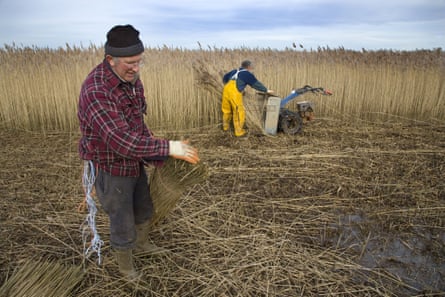
The humble bulrush does not look like the next big thing in fashion. Growing in marshes and peatland, its brown sausage-shaped heads and fluffy seeds are a common sight across the UK. Yet a project near Salford in north-west England is aiming to help transform the plant into an environmentally friendly alternative to the goosedown and synthetic fibres that line jackets, boosting the climate and the productivity of rewetted peatland in the process.
BioPuff, a new plant-based material manufactured by the startup Saltyco using bulrushes, has a similar structure to feathers, providing warm, lightweight and water-resistant insulation, according to the firm.
To boost the availability of the bulrushes, the Wildlife Trust for Lancashire, Manchester and North Merseyside has joined forces with a local farmer and a landowner on a five-hectare (12-acre) site in one of the UK’s first paludiculture (farming on rewetted peat) trials, with a £400,000 grant from the UK government.
If scalable, the material could line clothing at a fraction of the environmental footprint of traditional stuffing. It has already gained plaudits in the fashion industry, winning the H&M foundation Global Change Award last year. It has been used in one small collection so far, by the Italian label YOOX, and the startup is in talks with more fashion houses.
About 20 bulrush heads are needed to make enough material for one jacket, and the first rushes are expected to be harvested from the UK site in 2026.
“The bulrush has an amazing high-volume structure,” says Finlay Duncan, a co-founder of Saltyco. “Its seed heads can expand about 300 times in size. It has these umbrella-like structures that mimic the natural structure of goosedown in terms of providing that nice lofty, fluffy feeling.”
For farmers on lowland peat in the north-west, it is hoped the trial could provide an alternative source of income while also reducing greenhouse gas emissions. The chosen site in Greater Manchester was drained for agriculture more than 50 years ago, something that will be reversed next year to plant the bulrushes. This could save 2,800 tonnes of CO2 equivalent by 2050 and boost biodiversity, according to the Wildlife Trust.
“I’ve been farming this land for 35 years and have seen steadily declining yields and increasing difficulty finding a market for traditional crops,” says Steve Denneny, who will be growing the bulrush crop on land owned by the Peel Group. “I think wetter farming could be the future for a lot of lowland agricultural peat, and it’s great to be part of it right at the start.”
Paludiculture has been given around £5m of funding for trials and experimentation, which also include farming sphagnum moss for peat-free compost. In some parts of the country, such as Norfolk, wetland farming on peatlands dates back to ancient times, with the eastern wetlands used to produce reeds for thatch.

For the project in Salford, the Wildlife Trust is collecting baseline data at the site, which will be rewetted this autumn to raise the water table. A control site will also be set up to monitor the business-as-usual scenario.
“If we can make this trial successful and upscale it, there is so much lowland peat in the UK that is crying out to be rewetted, both environmentally and economically,” says Mike Longden of the Wildlife Trust.
“Farming on lowland peat can be really difficult. It’s not the most profitable farming.” Ideas like the bulrush project, therefore, could mean a lucrative “win-win”, says Longden.
Find more age of extinction coverage here, and follow biodiversity reporters Phoebe Weston and Patrick Greenfield on Twitter for all the latest news and features


